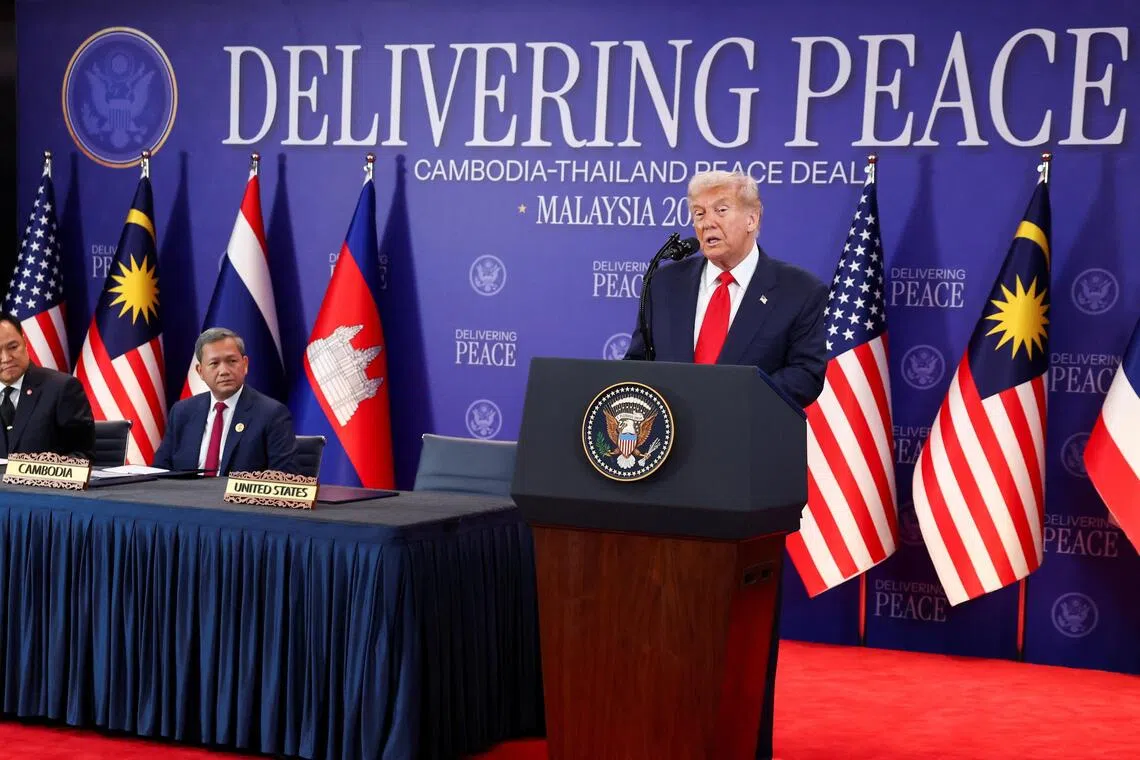What we know about the Thailand-Cambodia truce deal touted by Trump
Sign up now: Get ST's newsletters delivered to your inbox

(From left) Thai Prime Minister Anutin Charnvirakul and Cambodian Prime Minister Hun Manet looking on as US President Donald Trump spoke ahead of the signing of a ceasefire deal in Kuala Lumpur on Oct 26.
PHOTO: REUTERS
Follow topic:
KUALA LUMPUR - US President Donald Trump jetted into Malaysia on Oct 26
Here’s what we know about their agreement to uphold a truce, Mr Trump’s role in sealing the deal, and the conflict at the heart of the matter.
What’s in the deal?
Thailand and Cambodia witnessed their worst cross-border clashes in decades
At least 40 people were killed and 300,000 forced to flee their homes as soldiers traded gunfire, fighter jets launched sorties and rocket barrages rained down.
The joint declaration between the Thai and Cambodia prime ministers
Both sides agreed to remove heavy weapons and landmines from the border, and to establish a ceasefire monitor team from the Asean bloc chaired by Datuk Seri Anwar.
They also agreed to “refrain from disseminating or promoting false information” in a bid to “foster an environment conducive to peaceful dialogue”.
Thailand will “promptly release” 18 captured Cambodian soldiers.
While the deal agrees that both sides will continue a dialogue through cross-border committees, it does not resolve the core territorial dispute which caused fighting to flare.
What’s Trump’s role?
Thailand and Cambodia agreed on an initial truce on July 28
But Mr Trump hoarded credit, describing himself as “the President of Peace” on social media at the time and recently boasting he had “proudly brokered” the armistice.
Both Thailand and Cambodia were courting trade deals with Washington amid Mr Trump’s global tariff blitz when he intervened, stoking speculation that the President used economic leverage to force the truce.
Mr Trump called the peace pact signing on Oct 26 a “monumental step”, and the White House swiftly announced new trade agreements with both countries.
A non-binding memorandum of understanding with Thailand outlines measures to increase cooperation on trading rare earth minerals, which are vital to tech products and of which China is the world’s leading producer.
The headline of the Cambodian trade deal confirms the 19 per cent levy the country had already secured this summer, a let-off from the 36 per cent Trump had been threatening.
Cambodian Prime Minister Hun Manet issued a statement on Oct 26 repeating his claim that he has nominated Mr Trump for a Nobel Peace Prize
Is it all solved?
The Thailand-Cambodia conflict flared over a smattering of border temples, contested because of a vague territorial demarcation made by Cambodia’s French colonial administrators in 1907.
The International Court of Justice granted Phnom Penh sovereignty over one of the most coveted temples in 1962 and a small patch of land around it in 2013, but Thailand does not recognise its jurisdiction.
The deal touted by Mr Trump in Kuala Lumpur does not wade into the specifics of the territorial spat, which has sparked numerous rounds of violence over decades.
Dr Khoo Ying Hooi, associate professor of international and strategic studies at Universiti Malaya, said any deal between the countries would be “more symbolic than substantive”.
“The border issues have been there for a long time,” she told BFM news radio.
Mr Trump’s comments, though, represent the deal as drawing a line under the dispute – like many other global showdowns he claims to have put to rest.
“This is a momentous day for all of the people of South-east Asia, as we sign a historic agreement to end the military conflict between Cambodia and Thailand,” he said.
“Today’s signing represents just one of eight conflicts that we’ve ended in eight months of the Trump presidency.” AFP

